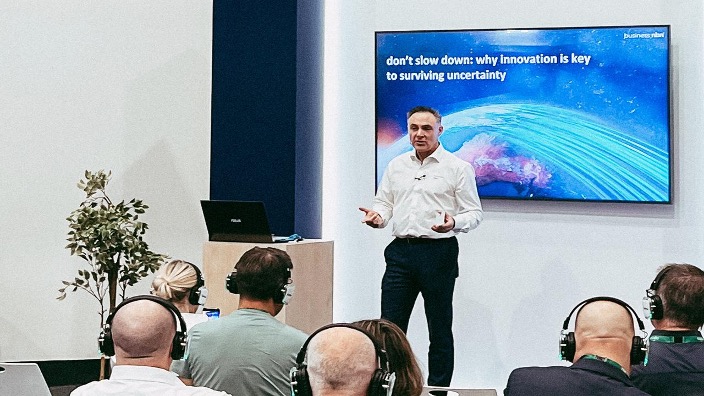As technology evolves, so must the strategies around digital connectivity. Using insights from last year’s Gartner IT Symposium/Xpo™, here’s what experts think is on the horizon.
Economic uncertainty is one of the few safe bets for 2023. According to research firm Gartner, it’s one of the top three external constraints to growth1, with the phrase ‘doing more with less’ showing up as a priority in conversations across every industry.
Despite the challenges, there will also be opportunities for organisations that strike the right balance between quick wins and long-term vision. Their ability to strike this balance – and to meet crucial sustainability goals – often comes back to making the right decisions about technology and digital connectivity. While no one can perfectly predict the future, there are emerging trends that help tell us where technology is headed.
The following are some of Gartner’s major predictions^ for business technology in 2023.
How digital immunity will cut downtime
As 76% of teams responsible for digital products are now also responsible for generating revenue2, many Chief Information Officers (CIOs) are looking for new ways to help their teams adapt to growing expectations and responsibilities. A digital immune system (DIS) can help get them there.
Gartner predicts by 2025, organisations that have invested in building digital immunity will reduce system downtime by nearly 80%3, which may also mean higher revenue.
Through a combination of practices and technologies working together to reduce performance risks, including measures like data-driven insights, automated testing, and automated incident resolution – a robust DIS can mitigate the effects of software bugs or security issues. It can also create a more resilient ecosystem that can recover more quickly from failures even when critical applications or services stop working.
Reimagining the office experience with the metaverse
Put simply, ‘the metaverse’ is a shared space between the digital and physical worlds that will enable new opportunities and business models as organisations extend their digital operations in decentralised, interoperable ways. While this means major potential for a variety of industries and brands, Gartner sees metaverse technologies creating an entirely new office experience and playing an outsized role in how we work.
By 2027, Gartner predicts that fully virtual workspaces will account for 30% of investment in metaverse technologies4 and that these will reimagine the office experience. Going beyond virtual reality (VR), Gartner expects this to result in an increased blurring between personal and professional workspaces.
For 2023 and 2024, however, expect to see metaverse technologies remain confined to innovators and early adopters.

Zero trust architecture
Zero trust architecture is a strategic approach to security that leverages network segmentation to continuously validate every stage of a digital interaction. Gartner expects that 60% of organisations will embrace it as a starting point for security by 20255, but only half will be successful in translating the technical reality into business benefits.
To navigate this and realise the full benefits of zero trust, Gartner stresses the importance of executive backing, and tying the approach back to business outcomes such as cost cutting and revenue generation.
Regional data sovereignty demands
Superapps set to emerge rapidly
Combining the features of an app, a platform and an ecosystem all in the one application, superapps have their own set of functionalities and provide a platform for third parties to develop and publish their own mini apps. Not only can a superapp replace multiple apps for both customers and employees on mobile, it can also do this on desktop.
Gartner already predicts that by 2027, more than 50% of the global population will be active daily users on multiple superapps6.

Businesses are looking to prune their vendors
‘Data fabric’ to drive decisions
As decisions become more complex, data and analytics are evolving to keep up. This is especially true where AI and automation can enhance human decision-making. Existing technology categories are already starting to coalesce, bringing together capabilities into a single environment, or ‘data fabric’. This term refers to an architecture and set of data services spanning hybrid, multi-cloud environments.
‘Data fabric’ consists of a single environment and unified architecture, as well as the services and technology that run on that architecture to help organisations manage their data. When determining which analytics tools to use and how to integrate them, Gartner predicts that organisations will need to work toward ‘data fabric’7, potentially even building new organisational structures and roles such as decision engineers.
Find support for your business
Sources
- https://www.gartner.com/en/newsroom/press-releases/2022-05-18-gartner-survey-reveals-significant-shifts-in-ceo-thinking-on-sustainability-workforce-issues-and-inflation-in-2022
- https://www.gartner.com/en/information-technology/insights/top-technology-trends
- https://www.gartner.com/en/articles/what-is-a-digital-immune-system-and-why-does-it-matter
- https://www.gartner.com/en/newsroom/press-releases/2022-10-18-gartner-unveils-top-predictions-for-it-organizations-and-users-in-2023-and-beyond
- https://www.gartner.com/en/newsroom/press-releases/2022-06-21-gartner-unveils-the-top-eight-cybersecurity-predictio
- https://www.gartner.com/en/newsroom/press-releases/2022-10-17-gartner-identifies-the-top-10-strategic-technology-trends-for-2023
- https://www.gartner.com/en/newsroom/press-releases/2022-03-29-gartner-identifies-three-imperatives-driving-the-top-trends-in-data-and-analytics-for-2022
You might also like
^Analysis and predictions made by Gartner Inc are general in nature and are not intended to constitute advice for your particular circumstances. You should make your own enquiries as to what technology and connectivity options are best for your business.
† business nbn is not available on the nbn Fixed Wireless network. Not all providers offer plans based on the full range of wholesale business nbn products, product features and services. Availability of wholesale business nbn products, product features and services depends on an end customer’s access technology and area. Ask your preferred provider if they offer plans based on these wholesale business nbn products, product features and services in your area.



